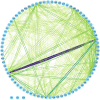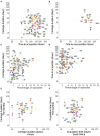Carriage Dynamics of Pneumococcal Serotypes in Naturally Colonized Infants in a Rural African Setting During the First Year of Life
- PMID: 33489998
- PMCID: PMC7820366
- DOI: 10.3389/fped.2020.587730
Carriage Dynamics of Pneumococcal Serotypes in Naturally Colonized Infants in a Rural African Setting During the First Year of Life
Abstract
Streptococcus pneumoniae (the pneumococcus) carriage precedes invasive disease and influences population-wide strain dynamics, but limited data exist on temporal carriage patterns of serotypes due to the prohibitive costs of longitudinal studies. Here, we report carriage prevalence, clearance and acquisition rates of pneumococcal serotypes sampled from newborn infants bi-weekly from weeks 1 to 27, and then bi-monthly from weeks 35 to 52 in the Gambia. We used sweep latex agglutination and whole genome sequencing to serotype the isolates. We show rapid pneumococcal acquisition with nearly 31% of the infants colonized by the end of first week after birth and quickly exceeding 95% after 2 months. Co-colonization with multiple serotypes was consistently observed in over 40% of the infants at each sampling point during the first year of life. Overall, the mean acquisition time and carriage duration regardless of serotype was 38 and 24 days, respectively, but varied considerably between serotypes comparable to observations from other regions. Our data will inform disease prevention and control measures including providing baseline data for parameterising infectious disease mathematical models including those assessing the impact of clinical interventions such as pneumococcal conjugate vaccines.
Keywords: Africa; acquisition; carriage duration; infants; pneumococcus; serotype.
Copyright © 2021 Chaguza, Senghore, Bojang, Lo, Ebruke, Gladstone, Tientcheu, Bancroft, Worwui, Foster-Nyarko, Ceesay, Okoi, McGee, Klugman, Breiman, Barer, Adegbola, Antonio, Bentley and Kwambana-Adams.
Conflict of interest statement
The authors declare that the research was conducted in the absence of any commercial or financial relationships that could be construed as a potential conflict of interest.
Figures






References
-
- Wahl B, O'Brien KL, Greenbaum A, Majumder A, Liu L, Chu Y, et al. . Burden of Streptococcus pneumoniae and Haemophilus influenzae type b disease in children in the era of conjugate vaccines: global, regional, and national estimates for 2000-15. Lancet Glob Heal. (2018) 6:e744–57. 10.1016/S2214-109X(18)30247-X - DOI - PMC - PubMed
Grants and funding
LinkOut - more resources
Full Text Sources
Other Literature Sources

